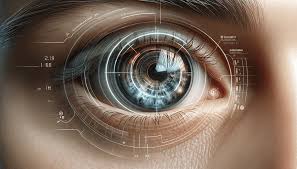Navigating Vision: A Deep Dive into Eye Tracking Innovations

Strong 8k brings an ultra-HD IPTV experience to your living room and your pocket.
Introduction:
Eye tracking technology has come a long way from its early days as a niche tool for researchers. Today, it is a cornerstone of innovation across multiple industries, including healthcare, gaming, marketing, and education. By analyzing eye movements, gaze patterns, and pupil dynamics, this technology provides unparalleled insights into human cognition and behavior. Recent advances, such as non-invasive techniques, have made eye tracking more accessible and practical, broadening its range of applications.
This article explores the evolution of eye tracking, its latest innovations, and its transformative potential, with a focus on the impact of non-invasive technologies.
The Growth of Eye Tracking Technology
Eye tracking has evolved significantly over the past few decades. Early systems relied on intrusive methods that required participants to wear cumbersome equipment or remain stationary. These limitations restricted the technology's use to controlled environments. Today, innovations in sensor technology, machine learning, and miniaturization have led to compact, efficient, and highly accurate eye-tracking systems.
Non-invasive eye tracking techniques are at the forefront of this transformation. These advancements are making it easier to integrate the technology into everyday devices, enabling real-world applications across diverse fields.
Advances in Non-Invasive Eye Tracking Techniques
Non-invasive eye tracking methods use external sensors, infrared light, and high-resolution cameras to monitor eye movements without requiring direct contact or intrusive equipment. Recent innovations in this area are addressing long-standing challenges, such as user comfort, system portability, and cost.
One major advancement is the use of remote infrared eye tracking, which eliminates the need for wearable devices. Infrared cameras capture the reflection of light from the cornea and pupil to track eye movements with precision. This technology is widely used in gaming, consumer electronics, and research environments.
Another breakthrough is the development of AI-driven algorithms that enhance the accuracy of non-invasive systems. By analyzing patterns in gaze data, these algorithms can predict user intent and provide detailed insights into cognitive processes.
Wearable devices like smart glasses and augmented reality headsets are also incorporating non-invasive eye tracking. These devices use lightweight sensors to monitor eye movements discreetly, enabling hands-free navigation and real-time feedback.
Applications of Non-Invasive Eye Tracking
The widespread adoption of non-invasive eye tracking is transforming industries by offering new ways to understand and interact with technology.
In healthcare, non-invasive systems are used for early diagnosis of neurological and vision-related disorders. For example, subtle changes in eye movement patterns can indicate conditions like Parkinson’s disease, Alzheimer’s, or multiple sclerosis. The ability to monitor these patterns without physical contact makes the technology ideal for clinical settings.
In gaming and Virtual Reality (VR), non-invasive eye tracking creates immersive experiences by allowing users to control interfaces with their gaze. Devices like the HTC Vive Pro Eye and Meta Quest Pro integrate this technology to enhance gameplay and improve accessibility for users with mobility challenges.
Download FREE Sample of Virtual Reality Market: https://www.nextmsc.com/virtual-reality-market/request-sample
The marketing industry benefits from non-invasive eye tracking through tools that analyze consumer attention and engagement. Heatmaps generated from gaze data provide insights into how users interact with ads, websites, and product designs, enabling brands to optimize their content effectively.
Education and training platforms are also leveraging non-invasive eye tracking to assess student focus and adapt teaching methods. Professional training programs, particularly in aviation and medicine, use simulators equipped with gaze-tracking technology to evaluate performance and improve outcomes.
Challenges of Non-Invasive Eye Tracking
While non-invasive techniques have made eye tracking more practical, challenges remain. The accuracy of remote systems can be affected by environmental factors like lighting conditions or user movement. Advances in AI and sensor technology are helping to address these issues, but further research is needed to enhance reliability.
Privacy concerns are another critical challenge. Non-invasive systems collect sensitive data, including gaze patterns and cognitive metrics, raising questions about consent and data protection. Transparent policies and robust security measures are essential to mitigate these risks.
Innovations Driving the Industry Forward
The integration of non-invasive eye tracking with other emerging technologies is opening new possibilities.
Artificial Intelligence (AI) and machine learning are driving improvements in gaze analysis, enabling systems to interpret subtle cues and provide deeper insights. For example, AI-powered platforms can detect emotional states or cognitive load based on eye movement patterns, offering applications in mental health, education, and user experience design.
Download FREE Sample of Artificial Intelligence Market: https://www.nextmsc.com/artificial-intelligence-market/request-sample
Wearable devices equipped with non-invasive sensors are making eye tracking more portable and accessible. Smart glasses, for instance, can monitor eye movements discreetly, offering real-time applications in fields like navigation, fitness, and productivity.
Edge computing is also enhancing the capabilities of non-invasive systems by enabling faster data processing and reducing latency. This improvement is particularly significant for applications like autonomous vehicles, where split-second decisions based on driver gaze can improve safety.
Eye Tracking and Mental Health
Non-invasive eye tracking is proving invaluable in mental health diagnosis and treatment. By analyzing gaze patterns, researchers can identify signs of conditions such as depression, anxiety, and schizophrenia.
Studies have shown that individuals with depression tend to fixate longer on negative stimuli, while those with anxiety exhibit rapid and erratic eye movements. These patterns provide objective data that clinicians can use to complement traditional diagnostic methods.
In cognitive behavioral therapy, eye tracking offers real-time feedback to help patients recognize and regulate their emotional responses. By making these interventions more personalized and effective, the technology is improving outcomes for individuals with mental health challenges.
The Future of Eye Tracking
The future of eye tracking lies in its seamless integration with everyday devices and its expanding applications in fields like healthcare, education, and autonomous systems.
Advances in non-invasive techniques will continue to drive adoption by improving user comfort, affordability, and system performance. Researchers are also exploring how eye tracking can enhance accessibility for individuals with disabilities, enabling hands-free control of devices and interfaces.
In healthcare, the technology is expected to become a standard tool for early diagnosis and monitoring of neurological and mental health conditions. As AI and machine learning continue to improve gaze analysis, the potential for eye tracking to provide actionable insights will only grow.
The rise of the metaverse and augmented reality platforms will further solidify the role of non-invasive eye tracking in creating intuitive, immersive experiences. From virtual collaboration to personalized entertainment, the technology is set to redefine how we interact with digital environments.
Conclusion
Eye tracking technology, particularly non-invasive techniques, is revolutionizing industries and improving our understanding of human behavior. By enabling applications in healthcare, gaming, marketing, and beyond, it is unlocking new possibilities and driving innovation.
As the technology evolves, addressing challenges related to accuracy, privacy, and accessibility will be essential. With its potential to transform how we interact with the world, eye tracking is poised to play a pivotal role in the future of technology and human connection.
Read the complete blog: https://www.nextmsc.com/blogs/eye-tracking-market-trends
Note: IndiBlogHub features both user-submitted and editorial content. We do not verify third-party contributions. Read our Disclaimer and Privacy Policyfor details.


